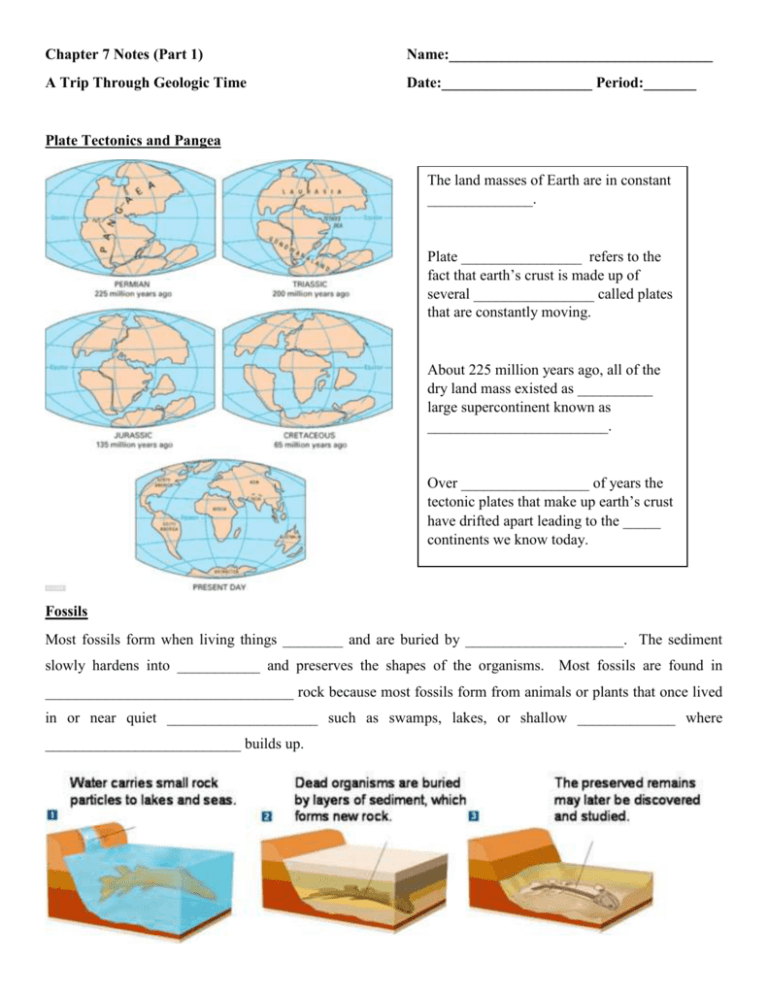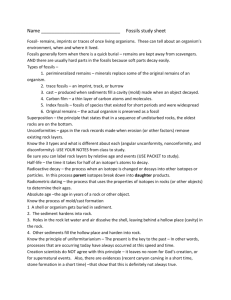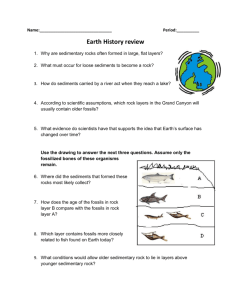Chapter 7 Notes: A Trip Through Geologic Time
advertisement

Chapter 7 Notes (Part 1) Name:___________________________________ A Trip Through Geologic Time Date:____________________ Period:_______ Plate Tectonics and Pangea The land masses of Earth are in constant ______________. Plate ________________ refers to the fact that earth’s crust is made up of several ________________ called plates that are constantly moving. About 225 million years ago, all of the dry land mass existed as __________ large supercontinent known as ________________________. Over _________________ of years the tectonic plates that make up earth’s crust have drifted apart leading to the _____ continents we know today. Fossils Most fossils form when living things ________ and are buried by _____________________. The sediment slowly hardens into ___________ and preserves the shapes of the organisms. Most fossils are found in _________________________________ rock because most fossils form from animals or plants that once lived in or near quiet ____________________ such as swamps, lakes, or shallow _____________ where __________________________ builds up. Types of Fossils Petrified Fossils – are fossils in which _________________________ replace part or all of an organism. Molds – a ________________ area in sediment in the shape of an organism or part of an organism. Casts – a solid copy (replica) of an organism which results when water may deposit __________________ into a mold. Carbon Films – an extremely ___________ coating of ______________________ on rock. When sediment buries an organism, some gases escape leaving carbon behind. This process can preserve the delicate parts of ________________ and ________________________. Trace Fossils – provide evidence of the __________________________ of ancient organisms. Examples are things such as a fossilized footprint, trail, or ________________________. Preserved Remains – result when an ___________________ organism is preserved. Examples are frozen fossils (like the baby wooly mammoth) and amber preserved fossils (like the “classic” Jurassic Park mosquito). Chapter 7 Notes (Part 2) Name:___________________________________ A Trip Through Geologic Time Date:____________________ Period:_______ How Old Are Rock Layers? RELATIVE DATING The Law of ___________________________ states that in _________________________ horizontal layers of sedimentary rock, the __________________ layer is on the bottom and each higher layer is ________________ than the layers below it. It should also be noted that “cross-cuts” seen in layers of sedimentary rock such as intrusions and extrusions are ___________________ than the layers that they cut through. Examine the diagram below and list the rock layers in order from OLDEST to YOUNGEST. _______ _______ _______ _______ ________ ________ Index fossils are useful because they tell the relative ages of the rock layers in which they occur. To be useful as an index fossil, a fossil must be _____________ distributed and represent an organism that existed for a geologically ______________ period of time. Examine the diagram. Which layer contains a good index fossil? _______ Why? There are __________ in the geologic record due to __________________ of sedimentary rock layers and loss of exposed rock layers due to _________________. This gap in the geologic record is called _______________________. --------------------------------------------------------------------------------------------------------------------------------------RADIOMETRIC DATING It has been discovered that although most elements do not change, some elements can break down, or _______, over time. These elements release particles and ____________ in a process called _______________________ decay. During the process of radioactive decay, the atoms of one element break down to form _____________ of another element. The _________ of decay for particular elements never changes. The _________________ of a radioactive element is the time it takes for __________ of the radioactive atoms to decay. EXAMPLE: The half-life of Carbon-14 is 5,730 years which means that if you start with a 100 gram sample of Carbon-14, in approximately 5,730 years there will only be 50 grams of Carbon14 left in the sample because half of it would have decayed. Complete the Chart Number of Half-lives 1 2 3 4 % of Original Element Remaining ______ ______ ______ ______ Sample Problem: A rock from the moon contains 12.5% of the potassium-40 it began with. How old is the rock? Step 1: Figure out how many half-lives have passed for that element. _________ Step 2: Multiply the number of half-lives from Step 1 by the time each half-life is worth using the information given in the table. Solution: ________ X ________ = _______________



![F3-4 Study Guide for QUIZ [1/28/2016]](http://s3.studylib.net/store/data/006814899_1-56a576b1a51c0f876f28a8da0f15de89-300x300.png)




